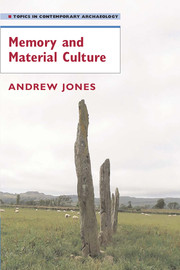Book contents
- Frontmatter
- Contents
- Preface
- 1 Memory and Material Culture?
- 2 From Memory to Commemoration
- 3 People, Time, and Remembrance
- 4 Improvising Culture
- 5 Continuous Houses, Perpetual Places: Commemoration and the Lives of Neolithic Houses
- 6 Culture, Citation, and Categorisation: Regionality in Late Neolithic Britain and Ireland
- 7 Chains of Memory: The Aesthetics of Memory in Bronze Age Britain
- 8 The Art of Memory: Memory, Inscription, and Place
- 9 Tracing the Past: Landscape, Lines, and Places
- 10 Coda
- References
- Index
6 - Culture, Citation, and Categorisation: Regionality in Late Neolithic Britain and Ireland
Published online by Cambridge University Press: 07 December 2009
- Frontmatter
- Contents
- Preface
- 1 Memory and Material Culture?
- 2 From Memory to Commemoration
- 3 People, Time, and Remembrance
- 4 Improvising Culture
- 5 Continuous Houses, Perpetual Places: Commemoration and the Lives of Neolithic Houses
- 6 Culture, Citation, and Categorisation: Regionality in Late Neolithic Britain and Ireland
- 7 Chains of Memory: The Aesthetics of Memory in Bronze Age Britain
- 8 The Art of Memory: Memory, Inscription, and Place
- 9 Tracing the Past: Landscape, Lines, and Places
- 10 Coda
- References
- Index
Summary
Although culture has been discussed by successive waves of archaeological theorists, the culture-historical description of material culture has remained remarkably resistant to change. Siân Jones points out that despite the critique of culture-history made by New or processual archaeologists, culture-historical categories were retained as a component of the core methodology of archaeology (Jones 1997, 27). However, the same charge could be made of postprocessual archaeologists. A good example of this can be observed in Julian Thomas's Time, Culture and Identity (Thomas 1996a), where, despite a thoroughgoing theoretical discussion on the nature of culture and identity, the case studies retain category descriptions formulated under quite different theoretical principles; such is the case in the final chapter, where arguments concerning the restructuring of the Late Neolithic henge at Mount Pleasant, Dorset (Thomas 1996a, 212–22), depends upon an analysis of the deposition of beaker sherds of specific culture-historical categories (e.g., Wessex/Middle Rhine; European; Northern; Southern). We are left, then, with complex theoretical approaches overlaid onto a series of traditional culture-historical categories. There is little interrelationship here between theory and practice.
Culture-history appears to be a fundamental component of archaeological method. This is because it fulfils the need for archaeologists to organise past material culture into coherent categories; categories offer a useful heuristic device – they provide archaeologist with a common descriptive reference point – but linguistic categories simultaneously circumscribe.
- Type
- Chapter
- Information
- Memory and Material Culture , pp. 122 - 140Publisher: Cambridge University PressPrint publication year: 2007

